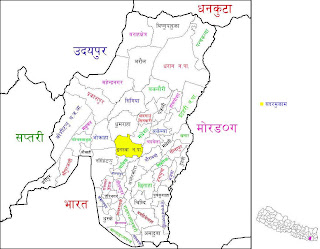 Dhankuta is a hill town of
Nepal located along the geographical coordinates- 26° 59' 0" N / 87° 20'
0" E, with about 20,000 inhabitants, located in the Dhankuta District in the eastern part of Nepal.
Until about 1963 Dhankuta Bazaar (the town) was the administrative headquarters
for the whole of north-eastern Nepal. Located a half mile above the town were
the buildings of the Bada Hakim, the feudal
district governor of the whole north-eastern region, a man with enormous power.
The town also had the regional jail and army post. Because of Dhankuta's
isolation from the
lowland Terai and from Kathamandu, it was in many ways a self-governing area.
Dhankuta is a hill town of
Nepal located along the geographical coordinates- 26° 59' 0" N / 87° 20'
0" E, with about 20,000 inhabitants, located in the Dhankuta District in the eastern part of Nepal.
Until about 1963 Dhankuta Bazaar (the town) was the administrative headquarters
for the whole of north-eastern Nepal. Located a half mile above the town were
the buildings of the Bada Hakim, the feudal
district governor of the whole north-eastern region, a man with enormous power.
The town also had the regional jail and army post. Because of Dhankuta's
isolation from the
lowland Terai and from Kathamandu, it was in many ways a self-governing area.
From 1963 Nepal was divided into 75
Panchayat Districts, and the traditional Dhankuta administrative region was
divided up into about six of the panchayat districts. The power of the Bada
Hakim was transferred to the central government's appointed Panchayat
Development Officer and each district's elected Panchayat President.
Now there is a sharp contrast
between Dhankuta Bazaar and the surrounding rural villages. The town is a
commercial center and has a population that is primarily Newar.
The surrounding area is agricultural and the population is made up of many
caste/tribal groups, notably Magar, Rai (Aathpaharias), Limbu, Tamang and Tibetan.
Dhankuta Bazaar, on the North-South
Koshi Highway, is now the administrative headquarters for the Eastern
Development Region, and is home to a number of offices for NGOs
and aid agencies serving in the area. The large bazaar of Hile further up the
road, is an important trading centre and major road head, serving the remote
hinterlands of the Arun valley and Bhojpur. Villagers walk for many days from
surrounding districts to trade in Hile and Dhankuta bazaars, although road
building in the district may reduce the importance of these centres. The
vegetation zones in the district range from sub-tropical Sal forest along the Tamur and Arun rivers, and
cooler temperate forests on some of the high ridges that mark the watershed
between the two catchments. The altitude ranges from around 300m to 2500m. The
majority of the population are involved in agriculture and crops include maize,
rice
and millet. Important cash crops include citrus
fruits, cauliflower, cabbage, ginger, and in recent years, tea.
A well-preserved forest (Rani Bhan - Queen's Forest) spreads along a ridge line
on the northwest side of the village, with well-developed mature stands of
rhododendron and pine trees.
 मोरङ जिल्ला औद्योगिक
एवं जनसंख्याको हिसाबले
नेपाल कै दोस्रो
ठूलो जिल्लाको रूपमा
परिचित छ। नेपालको
पूर्व तराइमा पर्ने
यो जिल्ला प्राचिनकालमा
विराट राजाको राजधानीको
रूपमा प्रख्यात थियो।
बिसं २०१८ सालको
प्रशासनिक विभाजन हुनुभन्दा अगाडी
३५ जिल्ला हुँदा
पनि यो एउटा
जिल्लामा अवस्थित थियो। जुन
हाल मोरङ, सुनसरी
तथा झापा जिल्लाहरूमा विभाजित
भएको छ। मोरङ
जिल्लाको क्षेत्रफल १,८५५
वर्ग किलोमिटर छ।
मोरङ जिल्लाको सदरमुकाम
र प्रमुख औद्योगिक
शहर विराटनगर
हो।
मोरङ जिल्ला औद्योगिक
एवं जनसंख्याको हिसाबले
नेपाल कै दोस्रो
ठूलो जिल्लाको रूपमा
परिचित छ। नेपालको
पूर्व तराइमा पर्ने
यो जिल्ला प्राचिनकालमा
विराट राजाको राजधानीको
रूपमा प्रख्यात थियो।
बिसं २०१८ सालको
प्रशासनिक विभाजन हुनुभन्दा अगाडी
३५ जिल्ला हुँदा
पनि यो एउटा
जिल्लामा अवस्थित थियो। जुन
हाल मोरङ, सुनसरी
तथा झापा जिल्लाहरूमा विभाजित
भएको छ। मोरङ
जिल्लाको क्षेत्रफल १,८५५
वर्ग किलोमिटर छ।
मोरङ जिल्लाको सदरमुकाम
र प्रमुख औद्योगिक
शहर विराटनगर
हो।










